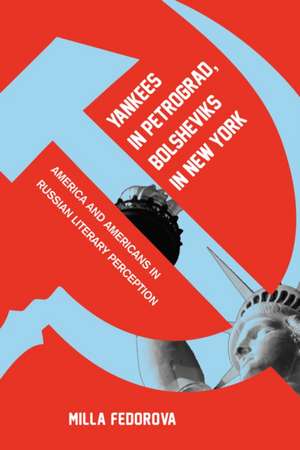Yankees in Petrograd, Bolsheviks in New York: America and Americans in Russian Literary Perception
Autor Milla Fedorovaen Limba Engleză Hardback – 29 iul 2013
Yankees in Petrograd, Bosheviks in New York examines the myth of America as the Other World at the moment of transition from the Russian to the Soviet version. The material on which Milla Fedorova bases her study comprises a curious phenomenon of the waning nineteenth and early twentieth centuries—pilgrimages to America by prominent Russian writers who then created travelogues. The writers’ missions usually consisted of two parts: the physical journey, which most of the writers considered as ideologically significant, and the literary fruit of the pilgrimages. Until now, the American travelogue has not been recognized and studied as a particular kind of narration with its own canons. Arguing that the primary cultural model for Russian writers’ journey to America is Dante’s descent into Hell, Federova ultimately reveals how America is represented as the country of “dead souls” where objects and machines have exchanged places with people, where relations between the living and the dead are inverted.
Preț: 451.44 lei
Nou
Puncte Express: 677
Preț estimativ în valută:
86.39€ • 93.81$ • 72.57£
86.39€ • 93.81$ • 72.57£
Carte tipărită la comandă
Livrare economică 23 aprilie-07 mai
Preluare comenzi: 021 569.72.76
Specificații
ISBN-13: 9780875804705
ISBN-10: 0875804705
Pagini: 389
Dimensiuni: 152 x 229 x 33 mm
Greutate: 0.61 kg
Ediția:New.
Editura: Northern Illinois University Press
Colecția Northern Illinois University Press
ISBN-10: 0875804705
Pagini: 389
Dimensiuni: 152 x 229 x 33 mm
Greutate: 0.61 kg
Ediția:New.
Editura: Northern Illinois University Press
Colecția Northern Illinois University Press
Recenzii
“This thought-provoking book profits from the author’s intimate knowledge of Russian and American culture, her analytical prowess, and her dry sense of humor. Dr. Fedorova’s study is a genuinely new contribution to the fields of Russian literature and cultural studies that should also be of interest to political scientists and historians.”
—Peter Rollberg, The George Washington University
“[Fedorova] shows how the travelogue model functions in fiction writings and what it adds to the image of America in Soviet literature of that time. This principle allows the author to have a fresh look at the literary process of the 1920s–1930s by integrating texts that are different in terms of genre and narrative style.”
—Modern Language Review
—Peter Rollberg, The George Washington University
“[Fedorova] shows how the travelogue model functions in fiction writings and what it adds to the image of America in Soviet literature of that time. This principle allows the author to have a fresh look at the literary process of the 1920s–1930s by integrating texts that are different in terms of genre and narrative style.”
—Modern Language Review
Notă biografică
Milla Fedorova is Assistant Professor in Russian Literature at Georgetown University.
Descriere
In Nikolai Chernyshevsky’s What Is to Be Done?, one of the protagonists feigns suicide and goes to America. In Fedor Dostoevsky’s Crime and Punishment, Svidrigailov, announces: “I’m going to America,” then commits suicide. When in America—“on the other shore,” as Russians sometimes put it—Russian émigré characters and writers often feel that, although they have now acquired a new life, this life approximates a posthumous experience. Although the country across the ocean had already begun to acquire concrete historical features in the Russian mind by the last quarter of the eighteenth century, connotations of the Other World, the land on the other side of earthly existence, still lurk in the background of literary texts about the New World. This mythological perception of the New World is not exclusively Russian, but in Russia the mythological concept gained a specificity and a concrete form that persisted through many eras and appeared in the works of very different authors.
Yankees in Petrograd, Bosheviks in New York examines the myth of America as the Other World at the moment of transition from the Russian to the Soviet version. The material on which Milla Fedorova bases her study comprises a curious phenomenon of the waning nineteenth and early twentieth centuries—pilgrimages to America by prominent Russian writers who then created travelogues. The writers’ missions usually consisted of two parts: the physical journey, which most of the writers considered as ideologically significant, and the literary fruit of the pilgrimages. Until now, the American travelogue has not been recognized and studied as a particular kind of narration with its own canons.
Fedorova posits three major stages in the development of the narrative of early twentieth-century American travelogues. First are the early, pre-Revolutionary travelogues characterized by the disillusionment of the socialist-oriented travellers in the forms that American democracy took in daily life. Second are the American travelogues written immediately following the 1917 October Revolution that are inspired by attempts to establish a new Soviet identity through the image of America as the Other and by the search for what could be borrowed from America to build the new Soviet state. Third are the travelogues written during the 1930s that are more documentary and less rhetorical, because Soviet ideology had already been established at home in the Soviet Union.
Arguing that the primary cultural model for Russian writers’ journey to America is Dante’s descent into Hell, Federova ultimately reveals how America is represented as the country of “dead souls” where objects and machines have exchanged places with people, where relations between the living and the dead are inverted.
